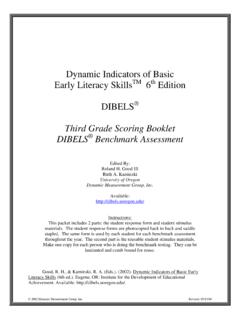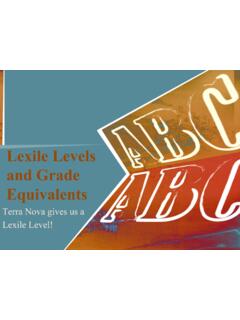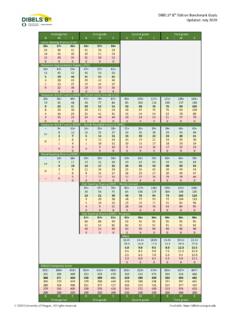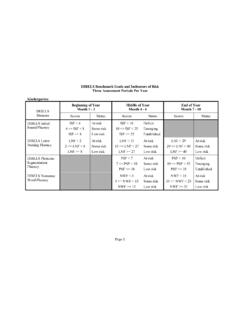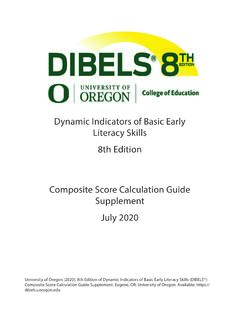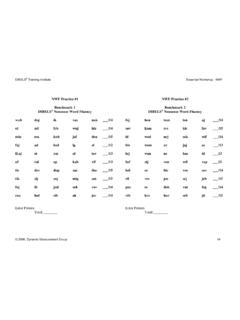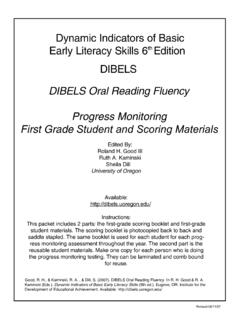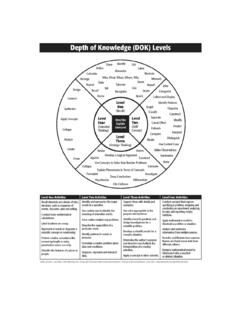Transcription of UNDERSTANDING DIBELS SCORES - Park City Reads
1 UNDERSTANDING DIBELS SCORES . What are DIBELS and what is assessed? The dynamic indicators of basic early literacy skills ( DIBELS ) are a set of procedures and measures for assessing the acquisition of early literacy skills from kindergarten through sixth grade . They are designed to be short (one minute) fluency measures used to regularly monitor the development of early literacy and early reading skills . DIBELS is a predictor of literacy strategies. DIBELS are comprised of seven measures to function as indicators of phonemic awareness, alphabetic principle, accuracy and fluency with connected text, reading comprehension, and vocabulary. DIBELS were designed for use in identifying children experiencing difficulty in acquisition of basic early literacy skills in order to provide support early and prevent the occurrence of later reading difficulties.
2 ( ). The Park City School District (PCSD) uses the DIBELS Next assessment to monitor the development of early literacy and early reading skills in Kindergarten through third for all students and in fourth and fifth grades for students at the intensive and strategic levels. As stated on the DIBELS website, DIBELS were designed for use in identifying children experiencing difficulty in acquisition of basic early literacy skills in order to provide support early and prevent the occurrence of later reading difficulties.. The PCSD assesses students three times each year (BOY: beginning of year; MOY: middle of year &. EOY: end of year). The five (5) key basic early literacy skills : 1.
3 Phonemic Awareness: The knowledge that spoken words can be broken apart into smaller segments of sound known as phonemes. This is the ability to blend sounds into words and take them apart (decode and encode). 2. Alphabetic Principle & Phonics: UNDERSTANDING the relationship between a specific letter and its sound, as it relates to the written word. The knowledge that letters of the alphabet represent phonemes and that these sounds blend together to form written words. Phonemes are the smallest unit of sound in a word. (cat = c/a/t; fish = f/i/sh). 3. Accurate and Fluent Reading: The ability to recognize words easily and to read accurately and smoothly with few mistakes.
4 4. Reading Comprehension: UNDERSTANDING what is spoken or read. Students demonstrate UNDERSTANDING using skills such as summarizing. 5. Vocabulary: UNDERSTANDING and correctly using a variety of words. Student increase vocabulary through text (using context clues) and individual vocabulary lists. How are DIBELS SCORES interpreted? What does benchmark mean? A DIBELS report will include both a Composite Score and individual section SCORES . The Goal listed on the sheet indicates the lowest score a student can receive to be considered at benchmark.. Benchmark SCORES indicate adequate reading progress. This means the student is likely to achieve the next benchmark goal.
5 Statistically, these students have an 80-90% chance to remain on benchmark throughout the year. While the Composite Score is considered to provide the best estimate of early literacy skills and/or reading proficiency, all of a student's individual SCORES should be reviewed. Some students with a Composite Score at benchmark may still need additional support in a specific area, as evidenced by a below benchmark score on an individual section. Green/Benchmark: Student obtained the benchmark score. Odds of achieving subsequent literary goals: 80-90%. Yellow/Strategic: Student fell below benchmark, but is within a range of SCORES for which success is more difficult to predict.
6 To ensure success, it is recommended that these students receive targeted additional support in the particular skills area, with regular monitoring. Odds of achieving subsequent early literacy goals: 40-60%. Red/Intensive: This score indicates that the student is unlikely to achieve reading goals without additional, targeted instructional support. The intensive support needed should incorporate something more or something different from the core curriculum. Odds of achieving subsequent early literacy goals: 10-20%. What happens if a student is not at benchmark? Each elementary school Principal is responsible for ensuring that DIBELS SCORES are reviewed and that appropriate interventions are provided to students.
7 This process is referred to within the schools as Response to Intervention or RTI. If you are concerned about your child's reading skills , please have a discussion with your child's teacher to find out if your child is receiving intervention through the school's RTI program. Useful information for reading the DIBELS report: Acronym Description Assessment Examples Area Assessed FSF First Sound Fluency Students are asked to identify the first sound from Phonemic Awareness a stated word. Examples: ride /r/, chin /ch/. LNF Letter Naming Fluency Naming both lowercase and uppercase letters. Does not measure a specific skill, but is an indicator of risk. PSF Phoneme Segmentation A word is spoken and the child is asked to name Phonemic Awareness Fluency all the sounds.
8 Examples: taste (t/ai/s/t); meant (m/e/n/t). NWF Nonsense Word Fluency Students are shown make-believe words and Phonics asked to read them. Examples: kub, yat DORF DIBELS Oral Reading Students are asked to read a short passage. Accuracy & Fluency Fluency Once finished, they are asked to retell the story. Words Correct/Fluency Scoring is done for words correctly read, Comprehension Accuracy accuracy (% words correct) and retell (points are Retell given for retelling the story based on the number of words used from the passage). DAZE Students are given a worksheet with a passage Comprehension on it with missing words. For each missing word, the student is instructed to circle the word choice (of 3 words) that best completes the sentence.
9 For more information: DIBELS : Five areas of reading: Response to Intervention (RTI): This document was prepared for parents by Park City Reads and the Park City School District.
